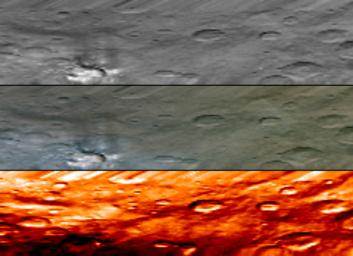Haulani Seen by VIR
Caption:
This image, from Dawn's visible and infrared mapping spectrometer (VIR), highlights a bright region on Ceres known as Haulani, named after the Hawaiian plant goddess.
Each row shows Ceres' surface at different wavelengths. On top is a black-and-white image; in the middle is a true-color image, and the bottom is in thermal infrared, where brighter colors represent higher temperatures and dark colors correspond to colder temperatures. The three images appear slightly flattened in the y-axis and smeared in the upper part due to the motion of the spacecraft.
These images were taken at a distance of 2,700 miles (4,400 kilometers) from Ceres and have a resolution of about 0.6 miles (1 kilometer) per pixel. They were produced on June 6, 2015.
Background Info:
Dawn's mission is managed by JPL for NASA's Science Mission Directorate in Washington. Dawn is a project of the directorate's Discovery Program, managed by NASA's Marshall Space Flight Center in Huntsville, Alabama. UCLA is responsible for overall Dawn mission science. Orbital ATK, Inc., in Dulles, Virginia, designed and built the spacecraft. The German Aerospace Center, the Max Planck Institute for Solar System Research, the Italian Space Agency and the Italian National Astrophysical Institute are international partners on the mission team. For a complete list of acknowledgments, see
http://dawn.jpl.nasa.gov/mission
.
For more information about the Dawn mission, visit
http://dawn.jpl.nasa.gov
.
Cataloging Keywords:
| Name |
Value |
Additional Values |
| Target |
1 Ceres |
|
| System |
Main Belt |
|
| Target Type |
Dwarf Planet |
Asteroid |
| Mission |
Dawn |
|
| Instrument Host |
Dawn |
|
| Host Type |
Orbiter |
|
| Instrument |
Visible and Infrared Spectrometer (VIR) |
|
| Detector |
|
|
| Extra Keywords |
Color, Infrared, Thermal |
| Acquisition Date |
|
| Release Date |
2015-07-28 |
| Date in Caption |
2015-06-06 |
|
| Image Credit |
NASA/JPL-Caltech/UCLA/ASI/INAF |
| Source |
photojournal.jpl.nasa.gov/catalog/PIA19608 |
| Identifier |
PIA19608 |

 Planetary Data System
Planetary Data System
